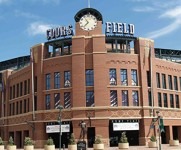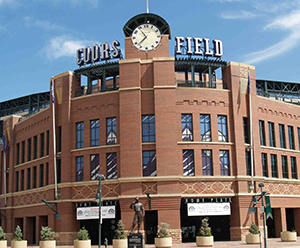Mortars, Mixtures and Staining
Mortar can be used for all masonry construction, but is all masonry construction best suited for the use of mortar?
By Alex Cheolas
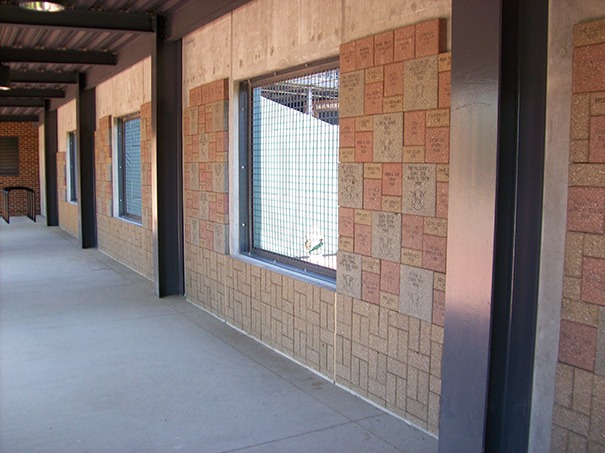
In 2004 ITW TACC did a market study of the masonry construction industry and realized an opportunity existed to develop a new product to make some masonry construction applications quicker, easier and more profitable for contractors, and improve product performance.
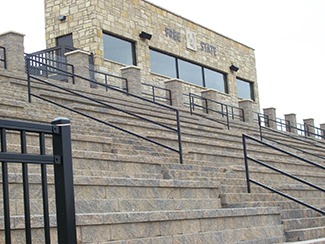
“As a result of our market study, we identified some areas where the industry needed a product that was easier to use than mortar, would increase worker productivity to lower labor costs, provide a quicker cure time, increase strength of the masonry assembly and reduced water penetration thru the assembly,” says Tim Walsh, product manager for ITW TACC. “We felt an adhesive product could be used to improve the performance in some specific segments of the business, like hardscape, residential housing including foundations, and some specialty applications where the use of mortar presented some challenges. One of the critical areas we felt we needed to address was acceptance by the building inspectors, architects, builders, developers and contractors for the use of an adhesive instead of mortar.”
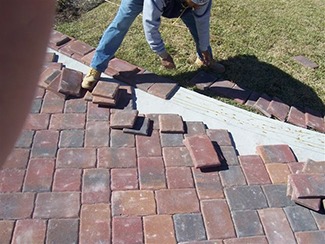
The company approached International Code Council Evaluation Services (ICC ES) to determine if an Evaluation Services Report could be obtained as an alternative to mortar. ICC ES did not have established Acceptance Criteria, which are the testing requirements a product must meet before an Evaluation Services Report will be issued. ITW TACC hired James Amrhein, the retired executive director of the Masonry Institute of America as a consultant to assist in the development of the Acceptance Criteria. As a result, ICC approved Acceptance Criteria 362 (ICC AC 362) “Acceptance Criteria for Adhesive for Masonry Construction” in February 2007. ITW TACC started the testing and, in November 2007, was issued ICC Evaluation Services Report 1968 (ICC ESR-1968) recognizing Mason Bond as an alternative to mortar meeting the requirements of the International Building Code and the International Residential Code.
Product WatchBlockade Mortar Deflection System |
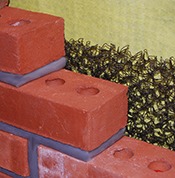 Benjamin Obdyke’s Blockade Mortar Deflection System is a masonry product designed to be used in conjunction with cavity wall construction to catch and hold mortar droppings during brick wall assembly. When installed, Blockade will help create a brick wall that is built to stand the test of time and remain free from the deteriorating effects of mold and moisture that can become trapped behind brick exteriors, while preventing mortar droppings from clogging the weep holes in the brick wall assembly. The patented black entangled matrix design of Blockade is produced in a diagonal orientation for use at the bottom of the wall cavity. It is available in two sizes. Blockade 80 measures .8 inches deep X 10 inches wide X 50 feet long, and weighs 4.5 pounds. As Blockade 150, it measures 1.5 inches deep X 10 inches wide X 35 feet long, weighing 3.5 pounds. For more information, visit www.benjaminobdyke.com. |
“The development of the Acceptance Criteria was a key step for us to bring our product, Mason Bond Masonry Adhesive, to the market,” says Walsh. “The Acceptance Criteria gave us and will give other adhesive companies the ability to develop products for masonry construction and, by receiving an Evaluation Services Report on the product, it gives building inspectors, architects, builders, developers, and contractors confidence to use these products. They been tested and are recognized as an alternative to mortar base on the evaluation of their structural, physical and durability properties.”
Just as ITW TACC started to move forward into the market, the economy went into the current downturn, resulting in a number of projects being delayed or cancelled for the time being. In the meantime, the product has been used for many unique applications that have been able to take advantage of the products advantages.
Choice of the Columbus Clippers
In 2009 the Columbus Clippers AAA baseball team opened their new baseball stadium in Columbus, Ohio. Having a long history in Columbus, the organization wanted to incorporate memorial pavers from the old stadium that were purchased by fans and supporters with their names engraved. The Columbus office of 360 Architecture designed the stadium and decided to have the pavers installed on the right field wall outside the stadium.
David Tyler, lead architect on the project, evaluated options and chose Mason Bond to adhere the pavers directly to the concrete wall. “Using Mortar would have required multiple steps to install the pavers with the installation of metal lathe onto the concrete wall,” Tyler says. “With the Mason Bond, we were able to adhere to the pavers directly to the concrete wall. In addition, the pavers were two inches thick, and some were 12 X 12 inches, so we were concerned the weight would approach the design limits of mortar.
Understanding Concentrated Mortar Colors |
| Solomon Colors Concentrated Mortar Colors A, H, X Series provide infinite possibilities to complement or contrast any masonry units utilized within commercial projects or one’s own personal home. Since 18 percent to 20 percent of the visual surface of the average brick wall is mortar, use of SGS Mortar Colors will enhance your projects value and individualism. The pre-measured unit concept of SGS provides uniform color control with the flexibility of utilizing local masonry and/or Portland and lime cements to achieve the proper strength and mix design for bricks, blocks, stucco or stone unit construction eliminating color variations caused by inaccurate jobsite dosages. SGS Mortar Colors are products of pure natural and/or synthetic iron oxides, which are finely milled and blended under strict quality control procedures producing uniform and consistently strong tinting strength for maximum coloring power. Test panels of selected jobsite materials, color and mixing procedures should be constructed, fully cured, and reviewed and accepted by all participating parties prior the actual construction. 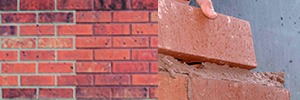
Proper Mixing A mechanical mixer should be used to assure proper mixing of the pigments, and only full batches should be mixed. To provide uniform color and workability, load the mixer as follows:
Finishing/Tooling
For more information, visit www.solomoncolors.com. |
“Test reports showed the bond strength with Mason Bond was more than 3.33 times stronger than code requirements and had better durability than mortar when exposed to environmental conditions that the wall would be exposed to, like freeze-thaw. In addition, we were installing the pavers a few days before the stadium would open, and we wanted to make sure the wall would be fully cured. Mason Bond would be as strong as mortar in four hours and would reach full cure within 24 to 48 hours.”
Can do in Kansas
When Kirk Brothers Inc. of Alvada, Ohio, installed the pavers, one of the initial challenges was assuring the pavers didn’t pull away from the wall as the adhesive was curing. Kirk Brothers was able to develop a simple, wooden brace for the system that applied positive pressure to the pavers and held them in place as the adhesive cured. After about 45 minutes, they were able to remove the brace, since Mason Bond then had enough strength to hold the pavers in place.
Polymer Modified Stone Veneer Mortar That Sticks |
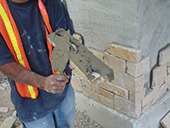 If you’ve ever installed a thin stone or brick If you’ve ever installed a thin stone or brickmasonry unit, only to have the stone or bricks sag and fall off the wall, youAny mason who has had callback issues with sagging stone veneer and thin stone units will more than appricateappreciate this new, pre-blended Polymer Modified Stone Veneer Mortar from SPEC MIX®. The SPEC MIX Polymer Modified Stone Veneer Mortar (PMSVM) is blend of dry cementitious materials, masonry sand and performance admixtures, including bonding agents specifically designed reduce sag during installation and increase adhesion of thin veneer masonry units without having to add liquid bonding agents. to provide superior bond for adhered manufactured and natural thin stone as well as thin brick veneer units. The blend of high performance materials used in SPEC MIX PMSVM reduce and eliminate sagging of the masonry unit during installation and delivers a high strength bond to the substrate. SPEC MIX PMSVM is a technically advanced mortar designed to provide excellent workability, SPEC MIX Polymer Modified Stone Veneer Mortar benefitsBenefits include:
SPEC MIX PMSVM significantly outperforms standard Type S and N mortar and is the preferred mortar for adhered thinstone veneer masonry installations. SPEC MIX PMSVM requires only water to be added; there are no bonding agents to mix on the jobsite. SPEC MIX PMSVM, and the product has taken the guesswork out of mortar production and selection for adhered stone veneer installation. For more information , visit on this innovative preblended stone veneer mortar product contact |
The high strength of Mason Bond resulted in C.L. Maurer, senior landscape architect at Landplan Engineering in Lawrence, Kan., specifying Mason Bond on two high school stadium projects, also in Lawrence. The School District of Lawrence Kansas decided to build new sports complexes, which included 8,000-seat football stadiums for both schools with soccer, softball and baseball facilities. Landplan designed the bleachers for the stadiums using retaining wall blocks, caps for the seats, and pavers. Construction of the stadiums was completed in August 2009.
During the design, Maurer expressed concern about the dynamic pressure load of people moving up and down the stadium stairs and the seats. Brad Minnick, sales manager of Capital Concrete, recommended Mason Bond for the project.
“I recommended Mason Bond, because it is three times stronger than other hardscape adhesives, and they have done extensive testing to verify its performance based on strength and durability,” Minnick says.
Long-term testing addressed various environmental conditions, including freeze-thaw, hot, cold, and wet-dry cycling that are typical to the conditions the stadiums are exposed to in Lawrence. The testing gave Landplan the confidence to specify Mason Bond for the projects.
“It is amazing how well it has held up since the project ended.” Maurer says.
ITW TACC didn’t expect the hardscape market to use Mason Bond, due to the higher cost of Mason Bond compared to other hardscape adhesives. “We discovered many architects and contractors have realized the performance benefits, including superior strength and quick cure time, and are specifying and using the product on special projects like the stadiums and other commercial hardscape projects.
“In addition, all of our testing was conducted using our recommended 3/16-inch diameter bead of adhesive and, as a result, a tube of Mason Bond will provide three times more coverage than other adhesives,” says Walsh. “This makes Mason Bond cost-competitive with the other adhesives. We are seeing a lot of use in other special hardscape applications like outdoor kitchens and fireplaces. Several manufacturers are specifying and selling Mason Bond as part of their package of materials for these projects.”
SURETOUCH
It’s not only within the hardscape area that ITW TACC sees Mason Bond as being used to meet special applications and masonry systems. Oldcastle Architectural has specified the use of Mason Bond with their SURETOUCH system. SURETOUCH is an exterior stone or brick finish installed on premoulded polystyrene (R-13) panels that allow for easy installation. Mason Bond is used to install the stone or brick onto the premoulded panel around corners, windows and doors. Mason Bond does not contain solvents that could attached the polystyrene and cause it to deteriorate, the product has Greengaurd Children and Schools certification. Another manufacturer is developing a masonry block basement system that uses Mason Bond instead of mortar and is currently in the final stage of testing. The company believes they will introduce the system in early-2011.
Walsh mentions other areas of use are in plant masonry construction: “We have customers building modular masonry assemblies in a factory, and then shipping them and installing them on a jobsite, in addition to modular outdoor living accessories. We have a customer making masonry fencing from CMUs, and then shipping the sections and installing them on site. The high strength allows the masonry to stay together as the modular units are shipped to the job location and then set in place.”
Walsh believes another area of opportunity is where the dust associated with mixing mortar could cause concerns on jobsites. “Active airport areas, where you would have the potential of the dust to get sucked into an airplane engine, or projects that may have activities taking place near the construction site, like the installation of a partition wall in a retail center, are examples,” he says.
For example, the conversion of a metal warehouse required several masonry offices built inside the warehouse without shutting down operations. Specialty Concrete of Elberta, Ala., built the offices using Mason Bond to set more than 2,000 CMUs.
“We had worked with Mason Bond previously in exterior architectural projects,” says Chris Geiger of Specialty Concrete.“We found Mason Bond to be efficient and flexible, so we immediately thought of using it for this unique project.”
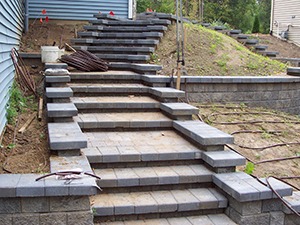
Geiger says that two features of Mason Bond were particularly helpful in the conversion of the warehouse. First, unlike mortar, there is no mixing involved; Mason Bond comes ready to use. This meant there was no mortar dust to deal with or clean up, and there was no need to seal off portions of the interior. Work was able to continue uninterrupted. In addition, Mason Bond was applied directly from a prepackaged tube, which made application in tight interior spaces much easier and simpler. It is estimated that using Mason Bond instead of traditional mortar cut construction time on the interior walls and labor costs by as much as 30 percent.
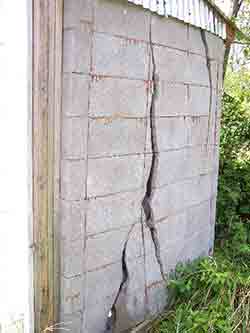
Although the company is excited by the progress being made, they do believe there is a place for Mason Bond for some of the conventional masonry market. Several masonry homes have been built using Mason Bond, and the company believes this market is a major growth opportunity.
“The masonry homes built with Mason Bond have the exterior coated with stucco, and they are finishing the inside, so the aesthetics of not seeing a mortar line have not presented a challenge,” Walsh says. “In fact, in a project that was built in Winter Park, Fla., the stucco contractor preferred there not be a mortar line and said it was much easier and faster to stucco the exterior.
“In addition, we see significant cost savings on the masonry construction itself. A ranch-style home built in Hawaii with CMUs and Mason Bond was expected to cost $16,000 for the masonry, but the contactor was able to complete it for slightly less than $12,000, due to the labor savings associated with using Mason Bond. That didn’t include the extra savings he realized on cleanup costs at the end of every day by not having to pick up mortar bags, secure a sand pile or clean up on tools.”
Walsh believes the biggest obstacle to overcome in conventional masonry is the block dimensional difference, due to the elimination of the 3/8-inch mortar line. A program recently launched with Baines Masonry of Australia that incorporates the use of Mason Bond with their Lockblock, which measures a full eight inches high X 16 inches long, and eliminates the dimensional difference. Walsh believes that, as the economy recovers in the United States, and builders and masons look for ways to increase productivity and decrease costs, similar programs will be developed.
Did You Know?Base, Accent Color Applications Help Blend Masonry Repairs |
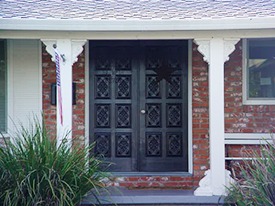 The natural firing process in the manufacturing of clay brick results in the formation of multiple color ranges. For renovation projects in which masonry is replaced, matching the older brick is sometimes difficult. Maintaining the proportion and texture of the new brick and getting close to the original color is sometimes difficult. The color of brick also depends upon chemical composition, firing temperature and method of firing. Iron in the clay also can have an effect on the final color. Clay containing iron in practically any form will exhibit a shade of red when fired. Different firing methods can give the brick different accent hues. 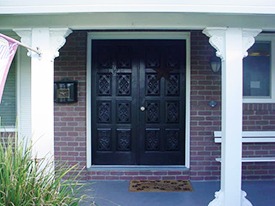 Clay bricks are composed of silica, alumina and metallic oxides. Metallic oxides can influence the color of brick. A brick manufacturer can minimize variations in colors by mixing clays from different regional locations. Clay can be different from region to region and from source to source. Therefore, brick from the same manufacturer can have different properties from different production runs. Brick from manufacturer to manufacturer may have a similar color and, yet, may differ in other properties such as denseness and surface texture. Penetrating stains can help keep the surface texture visible. Painting a thick coating over the masonry will only hinder the original effort of matching surface texture and size. In the event that surface texture cannot be closely matched, fine aggregates can be added to the stain base to simulate the finish of the existing masonry. Aggregate options, such as recycled glass and sand, can be successful additives for adding custom texture to masonry. The brick will benefit from a base coat of stain to help get close to the base color of the original masonry. From there, color ranges can be determined. These can be applied on top of the base coat in multiple passes. This layering of color helps give the replacement masonry a more natural appearance. It’s important to match as closely as possible any red, yellow, white or black accents found in the original masonry. Gray and black accents can bring down the intensity of colors to give a more weathered appearance to help further blend the old with the new. Look for water-based stains, especially for vertical surfaces, where acid stains may not be feasible. The penetrating nature of stains makes them quick-drying with shortened cure times. Most companies offer color palettes to choose from, and a few can help with custom color development for your project. When choosing a color palette, be sure to take into consideration the original brick. As most stains are somewhat transparent in nature, this will affect the final color matching results. For more information, visit www.nawkaw.com. |
